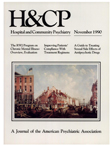Characteristics of Sheltered Care Facility Operators in California in 1973 and 1985
Abstract
During the past 20 years, sheltered care homes have become the primary supervised community residence for mentally ill patients outside of licensed hospitals. To determine factors associated with sheltered care operators' remaining in business, follow-up interviews were conducted in 1985 with operators of 151 sheltered care facilities in California whose operators had been surveyed in 1973. Fiftyfive of the original operators continued to operate the facility at 12year follow-up, and 96 were new to the facilities since 1973. Compared with the original operators, the new operators were younger and better educated, were more likely to be men, and were more likely to be totally dependent on the business for their income. Operators who were members of local associations for sheltered care operators were more likely to have remained in business over the 12-year period, as were those who owned facilities with more than six beds.
Access content
To read the fulltext, please use one of the options below to sign in or purchase access.- Personal login
- Institutional Login
- Sign in via OpenAthens
- Register for access
-
Please login/register if you wish to pair your device and check access availability.
Not a subscriber?
PsychiatryOnline subscription options offer access to the DSM-5 library, books, journals, CME, and patient resources. This all-in-one virtual library provides psychiatrists and mental health professionals with key resources for diagnosis, treatment, research, and professional development.
Need more help? PsychiatryOnline Customer Service may be reached by emailing [email protected] or by calling 800-368-5777 (in the U.S.) or 703-907-7322 (outside the U.S.).



